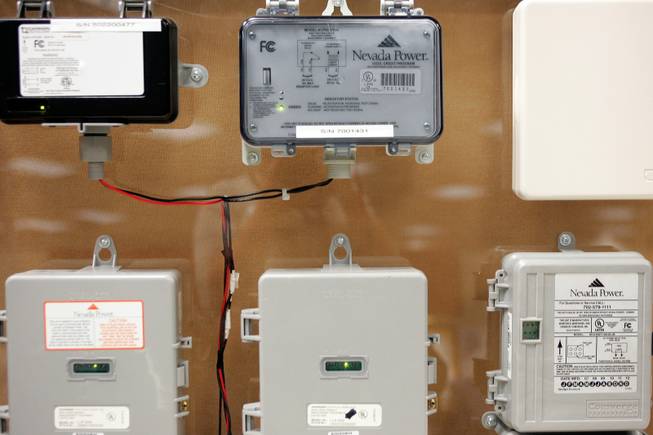
Switches at the Las Vegas headquarters of NV Energy, formerly Nevada Power, help the utility regulate energy consumption as part of its Cool Share program. A University of Michigan study of residential energy use in the 50 largest cities in the United States placed Las Vegas in the middle of the pack.
Thursday, Nov. 20, 2008 | 2 a.m.
Anyone who has lived through a scorching Nevada summer and survived the accompanying power bills might assume that Las Vegas homes use more energy each year than homes in other cities.
A study has found that’s not necessarily the case. In fact, it ranks Las Vegas smack in the middle of a list of America’s 50 largest metro areas for residential energy use for heating and cooling.
Because although Las Vegans might crank their air conditioners to battle incredible heat for three or four months, residents of cold weather states turn their heaters higher and for longer periods of time.
The study, by University of Michigan Transportation Research Institute researcher Michael Sivak, says because heating and cooling make up 53 percent of all residential energy use, where you live can really make a difference when it comes to how much you spend on energy. And it can change your effect on the environment, too.
“It is likely such differences will be an increasingly important factor in ... decision-making about where to live,” Sivak writes.
But Lydia Ball, of the local Sierra Club, notes that people are more likely to choose new homes based on job availability or family situation than what it will do for their carbon footprint. And even environmentally minded people who might think about how much energy they’ll use when choosing their homes have more to consider than just air conditioning and heating, such as availability of public transportation and locally grown food.
“If you’re looking to make the least carbon footprint, energy consumption isn’t the only issue,” Ball says.
Still, Sivak says, “this is one important consideration, especially in a future with increased (energy) costs.”
The study doesn’t consider energy prices in each city or the energy efficiency of homes and appliances in different regions — only the amount of energy used.
It counts what are known as heating and cooling degree days. If the low for a given day is 70 degrees and the high is 100 degrees, for example, the average temperature for that day is 85 degrees. With a typical industry standard indoor temperature of
65 degrees, an 85-degree day counts as 20 cooling degree days.
Electric companies such as NV Energy would count these cooling degree days, while gas companies such as Southwest Gas would count heating days.
Add the heating degree days and cooling degree days, as Sivak’s study does, and you get an idea of how much energy is used year-round in the region.
He gathered data for the nation’s 50 largest metro regions, all of which have more than 1 million residents.
And though Las Vegas has 3,029 heating and cooling degree days, according to the study, cities such as Boston, New York and Buffalo have more.
Temperate cities such as San Diego, San Francisco and Los Angeles were at the bottom of the list. In fact, the six metro areas with the lowest scores — meaning they used the least energy for residential heating and cooling overall — were in California.
Cities such as Las Vegas and Phoenix, where residents run their air conditioners a lot but their heating systems seldom, landed in the middle of the pack.
Terry Baxter, who predicts energy demand for NV Energy, says Sivak’s method for determining the number of heating and cooling degree days is accurate, but added the utility uses more up-to-date temperature statistics to make its estimates. The study used temperatures from 1971 to 2000 in its calculations, and NV Energy used data from 1988 to 2007 to predict the number of cooling degree days in Southern Nevada this year.
“It’s gotten a lot hotter,” Baxter said.
According to records from McCarran International Airport’s weather station, the average number of heating and cooling days for 2001 through 2007 was 3.4 percent higher than the figure used in Sivak’s study.

Join the Discussion:
Check this out for a full explanation of our conversion to the LiveFyre commenting system and instructions on how to sign up for an account.
Full comments policy